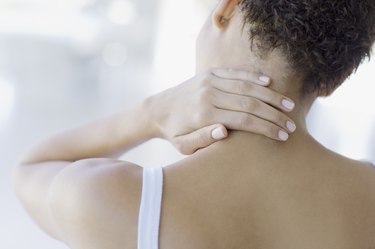
Lactic acid was once thought to cause the "burn" of a working muscle and the soreness afterward. But in the ever-evolving field of exercise science it's now understood that when all your body's systems work as expected, lactic acid in muscles is a natural, even helpful, by-product of exercise.
Warning
Although lactic acid is a natural by-product of intense exercise, lactic acidosis is something very different. As the U.S. National Library of Medicine warns, lactic acidosis is the buildup of lactic acid in your bloodstream, often caused by severe illness. Intense exercises can be a trigger too. If this sounds like what you're experiencing, contact a doctor right away.
Video of the Day
Lactic Acid in Muscles
Scientists have gone from considering lactic acid as the cause of your burning muscles to seeing it as your body's attempt to fix that "burn." As exercise researchers from the University of New Mexico explain, lactic acid is a natural by-product of muscular activity — even when those muscles are at rest.
Video of the Day
Lactic acid production does speed up as you exercise harder, but it's now believed to be an attempt at neutralizing the acidic environment in your hard-working muscles. When lactic acid forms in your muscles, it takes up the protons that are now believed to be the actual cause of that burn you feel in those muscles when you work out.
So what is to blame for sore muscles after a tough workout? Just as scientific understanding of lactic acid has evolved, so has understanding of the soreness it was once thought to cause.
As noted in the December 2018 issue of the German journal Sportverletz Sportschaden, delayed onset muscle soreness, or DOMS, is now believed to be a very mild injury to the muscle. Soreness usually peaks two to three days after the workout that caused it, then fades within a few days.
The authors of a March 2017 perspective article in Sports Medicine even go so far as to describe DOMS as a very mild form of rhabdomyolysis. The severe soreness of rhabdomyolysis, or "rhabdo," is a life-threatening condition in which muscle tissue breaks down and releases muscle protein into your bloodstream. Milder cases of DOMS, on the other hand, typically go away on their own.
Dealing With DOMS
That doesn't mean you're helpless in the face of DOMS. While DOMS is often a natural result of taking on a new workout, you can reduce its occurrence by easing into new workouts gradually and minimizing the emphasis on eccentric contractions, which the Sportverletz Sportschaden article notes is believed to play an important role in the development of DOMS.
As the Mayo Clinic notes, taking the time to warm up before your workouts may help prevent or reduce DOMS. The scientific jury is still out on whether a post-workout cool-down reduces DOMS. But as the Mayo Clinic emphasizes, cooling down provides other benefits, including a gradual recovery of heart rate and blood pressure levels.
Read more: How to Ease Muscle Soreness After a Workout
Tip
Eccentric contractions are when the muscle lengthens under load or, to put it another way, when you control the descent of a weight against gravity. For example, the downward-moving portion of a bench press or biceps curl exercise.
What about treatments for an existing case of DOMS? Scientists are still searching for conclusive evidence, but theories — often backed by anecdotal evidence or a slim body of studies — abound.
For example, stretching might help. The most comprehensive systematic review available, published in the July 2011 issue of Cochrane Database of Systematic Reviews, did find one study that demonstrated statistically significant reductions in soreness from post-exercise stretching — but those reductions were still fairly small.
With that said, stretching feels good, can increase your range of motion and is helpful for preventing injury — so it's well worth doing.
Massage shows excellent promise as a treatment for DOMS. In a meta-analysis published in the April 2018 issue Frontiers in Physiology, massage was determined to be the most effective treatment for DOMS, perhaps because it increases circulation to the affected area.
No time or money for a massage? Heat can increase circulation too. According to a study published in the December 2013 issue of the Journal of Clinical Medicine Research, the application of moist heat packs for two hours or dry heat packs for eight hours hastened recovery from DOMS.
- University of New Mexico: "Lactate Threshold Training"
- Sports Medicine: "Perspectives on Exertional Rhabdomyolysis"
- Sportverletz Sportschaden: "Advances in Delayed-Onset Muscle Soreness (DOMS)"
- Mayo Clinic: "Aerobic Exercise: How to Warm Up and Cool Down"
- Cochrane Database of Systematic Reviews: "Stretching to Prevent or Reduce Muscle Soreness After Exercise"
- Frontiers in Physiology: "An Evidence-Based Approach for Choosing Post-Exercise Recovery Techniques to Reduce Markers of Muscle Damage, Soreness, Fatigue, and Inflammation"
- Journal of Clinical Medicine Research: "Moist Heat or Dry Heat for Delayed Onset Muscle Soreness"
- U.S. National Library of Medicine: "Lactic Acidosis"
Is this an emergency? If you are experiencing serious medical symptoms, please see the National Library of Medicine’s list of signs you need emergency medical attention or call 911.